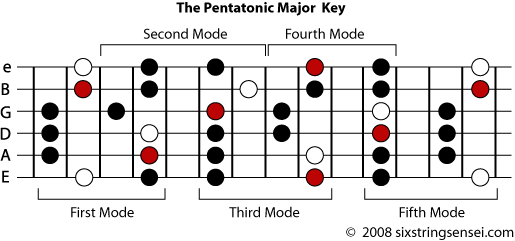Pentatonic Major Key

All the positions of the pentatonic major scale put together.
This is it! Now that you know every position of the major pentatonic scale it’s time to put them all together as one big entity. Look closely at the diagram below. See how all the positions and mode patterns interject. Notice that the notes on the right of each of the modes are the same as the notes on the left of the following mode. So all you have to do is match them. Now you must practice them altogether so you can easily switch from one box to the next while staying in the same key. It’s really that simple. We’ve been learning these in the key of G, so first white note in the first mode is the G at the 6th string 3rd fret. Therefore all the white notes are G’s and all the red notes (5ths) are D’s. Remember, when I say 5ths I means the perfect fifth’s of the G major scale which is D. Don’t get confused. If you count them in order starting on the G at the 6th string, 3rd fret, you’ll count 4 notes in order to get to the D. But the reason for this is we dropped the 2nd note and the 6th note of the G major scale in order to turn that scale into a pentatonic. Therefore, that D (the red dot on the 5th string 5th fret) is a perfect 5th of G. Don’t forget that.
If you were going to play this in the key of A for example. You would match that first white note in the First Mode to the 6th string 5th fret A. In that case all the white notes would be A’s and all the red notes (5ths) would be E’s. Just remember that when you begin further up the neck, you are going to run out of “fingerboard” so the notes will have to be repeated at the bottom end of the neck near the headstock. Basically, you would be playing the modes in order and when you run out of neck, jump back to the beginning of the neck (lower notes) and continue the modes. Remember, they simply keep repeating themselves within the available octaves.


